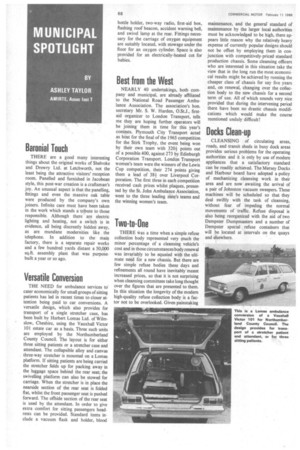MUNICIPAL SPOTLIGHT
Page 70

If you've noticed an error in this article please click here to report it so we can fix it.
BY ASHLEY TAYLOR AMIRTE, Assoc hist
Baronial Touch
THERE are a good many interesting things about the original works of She!yoke and Drewry Ltd. at Letchworth, not the least being the attractive visitors' reception room. Panelled and furnished in Jacobean style, this post-war creation is a craftsman's joy. An unusual aspect is that the panelling, fittings and even the massive oak table were produced by the company's own joiners. Infinite care must have been taken in the work which stands a tribute to those responsible. Although there are electric lighting and heating, not a switch is in evidence, all being discreetly hidden away, as are mundane modernities like the telephone. In addition to the main factory, there is a separate repair works and a few hundred yards distant a 50,000 sq.ft. assembly plant that was purposebuilt a year or so ago.
Versatile Conversion
THE NEED for ambulance services to cater economically for small groups of sitting patients has led in recent times to closer attention being paid to car conversions. A versatile .design, which also provides for transport of a single stretcher case, has been built by Herbert Lomas Ltd. of Wilmslow, Cheshire, using the Vauxhall Victor 101 estate car as a basis. Three such units are employed by the Northumberland County Council. The layout is for either three sitting patients or a stretcher case and attendant. The collapsible alloy and canvas three-way stretcher is mounted on a Lomas platform. If sitting patients are being carried the stretcher folds up for packing away in the luggage space behind the rear seat; the swivelling platform can also be stowed for carriage. When the stretcher is in place the nearside section of the rear seat is folded flat, whilst the front passenger seat is pushed forward. The offside section of the rear seat is used by the attendant. In order to give extra comfort for sitting passengers headrests can be provided. Standard items include a vacuum flask and holder, blood bottle holder, two-way radio, first-aid box, flashing roof beacon, accident warning bell, and swivel lamp at the rear. Fittings necessary for the carriage of oxygen equipment are suitably located, with stowage under the floor for an oxygen cylinder. Space is also provided for an electrically-heated cot for babies.
Best from the West
NEARLY 40 undertakings, both company and municipal, are already affiliated to the National Road Passenger Ambulance Association. The association's hon. secretary Mr. S. W. Harden, 0.St.J., firstaid organizer to London Transport, tells me they are hoping further operators will be joining them in time for this year's contests. Plymouth City Transport acted as host for the final of the 1965 competition for the Stirk Trophy, the event being won by their own team with 3204 points out of a possible 400, against 273 by Edinburgh Corporation Transport. London Transport women's team were the winners of the Lewis Cup competition, their 274 points giving them a lead of 38+ over Liverpool Corporation. The first three in each competition received cash prizes whilst plaques, presented by the St. John Ambulance Association, went to the three leading men's teams and the winning women's team.
Two-to-One
THERE was a time when a simple refuse collection body represented very much the minor percentage of a cleansing vehicle's cost and in those circumstances body renewal was invariably to be equated with the ultimate need for a new chassis. But there are few simple refuse bodies these days and refinements all round have inevitably meant increased prices, so that it is not surprising when cleansing committees take long thought over the figures that are presented to them. In this situation the longevity of the modern high-quality refuse collection body is a factor not to be overlooked. Given painstaking maintenance, and the general standard of maintenance by the larger local authorities must be acknowledged to be high, there appears little reason why the relatively heavy expense of currently popular designs should not be offset by employing them in conjunction with competitively-priced standard production chassis. Some cleansing officers who are interested in this situation take the view that in the long run the most economical results might be achieved by running the cheaper class of chassis for say five years and, on renewal, changing over the collection body to the new chassis for a second term of use. All of which sounds very nice provided that during the intervening period there have been no drastic chassis modifications which would make the course mentioned unduly difficult!
Docks Clean-up
CLEANSING of circulating areas, roads, and transit sheds in busy dock areas provides serious problems for the operating authorities and it is only by use of modern appliances that a satisfactory standard can be readily achieved. The Mersey Docks and Harbour board have adopted a policy of mechanizing cleansing work in their area and are now awaiting the arrival of a pair of Johnston vacuum sweepers. These machines will be scheduled so that they deal swiftly with the task of cleansing, without fear, of impeding the normal movements of traffic. Refuse disposal is also being reorganized with the aid of two Dempster Dumpmasters and a number of Dempster special refuse containers that will be located at intervals on the quays and elsewhere.




























































































































